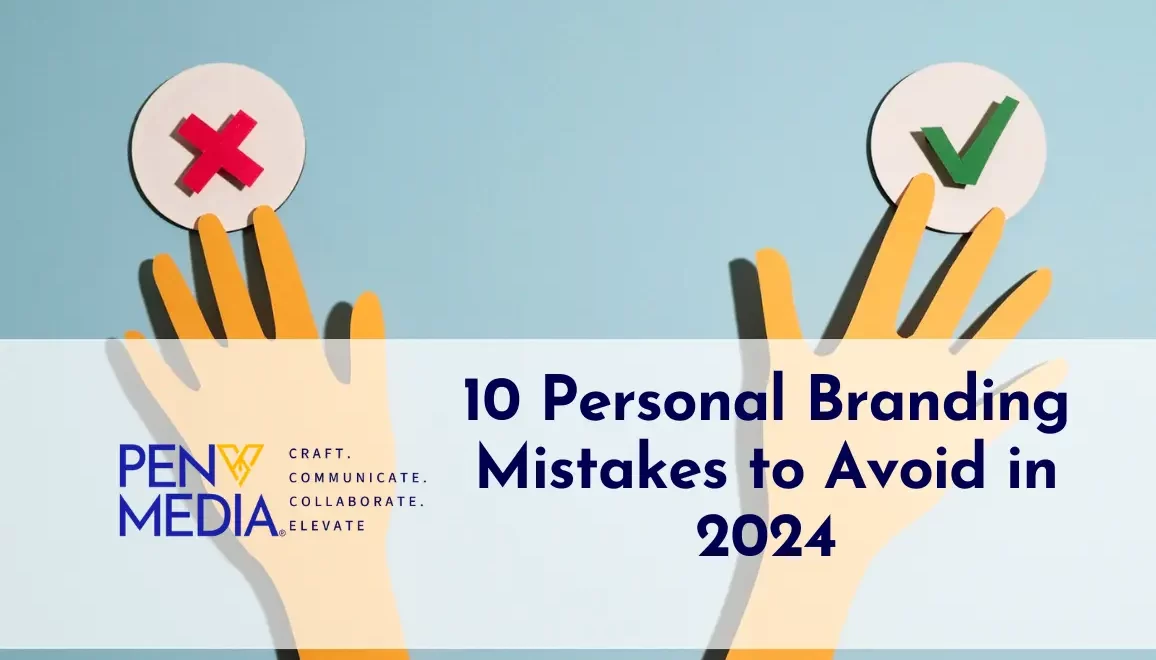Personal branding is no longer optional. Whether you’re an entrepreneur, freelancer, or corporate professional, your personal brand significantly impacts how others perceive you. It shapes career prospects, client interactions, and overall success. However, navigating this terrain requires vigilance, as missteps can impede your progress. Let’s delve into ten common personal branding mistakes and learn how to sidestep them.
10 Common Personal Branding Mistakes
Building a strong personal brand is essential in today’s professional landscape, but it’s easy to make mistakes that can undermine your efforts. Whether you’re an entrepreneur, executive, or professional, avoiding common pitfalls is crucial for maintaining a credible and impactful presence. Here are ten common personal branding mistakes:
Inconsistency
One of the biggest mistakes in personal branding is failing to align your brand message across all platforms. From social media profiles to your professional website, ensure that your message is consistent to avoid confusing your audience.
Undermining Authenticity
Authenticity is key to building a strong personal brand. If you are not genuine, transparent, and true to your values, your audience will likely notice and lose trust in you.
Neglecting Your Online Presence
An outdated LinkedIn profile or website can damage your professional image. Regularly updating all online platforms is crucial to reflect your current achievements and roles accurately.
Not Taking Feedback
Constructive feedback is valuable for personal growth and brand development. Ignoring feedback can prevent you from making necessary improvements and adapting your brand to better meet the needs of your audience.
Lacking Clarity
A vague or poorly defined unique value proposition (UVP) can dilute your personal brand. It’s important to clearly define what sets you apart and communicate it effectively to your audience.
Neglecting Visual Branding
High-quality visuals play a significant role in personal branding. Investing in professional headshots, logos, and consistent visual elements can greatly enhance your brand’s image and credibility.
Overlooking Consistent Messaging
Inconsistent voice, tone, and messaging can confuse your audience and weaken your brand. Ensure that your brand message is cohesive and consistent across all communications.
Loosing Out Networking Opportunities
Avoiding industry events, webinars, and other networking opportunities can limit your professional growth. Actively engaging with peers and attending relevant events can help you expand your network and build valuable connections.
Neglecting Personal Development
Stagnation can harm your personal brand. Continuously learning, growing, and showcasing your evolving expertise is essential to maintaining a strong and relevant brand.
Failing to Tell Your Story
Your personal story is a powerful tool for connecting with your audience. Failing to share your journey, experiences, and passions can make your brand less relatable and engaging.
Your personal brand is a powerful asset, and these rookie mistakes can dash your efforts and intent in an instant. Read on to find out how to avoid them:
Authenticity Matters
Authenticity serves as the bedrock of effective personal branding. When you present yourself authentically, you create a genuine connection with others. Here are some key points to consider:
Be True to Yourself:
- Authenticity involves being genuine and transparent. Rather than projecting a polished facade, share your real story—the journey, vulnerabilities, and triumphs.
- People resonate with authenticity because it feels relatable and human. Authentic individuals are more likely to build trust and loyalty.
Transparency and Credibility:
- Misrepresenting your expertise can harm your credibility. Avoid exaggerating your skills or accomplishments.
- Instead, focus on continuous learning and growth. When you encounter something you don’t know, embrace honesty. Authenticity shines through transparency.
Embrace Imperfections:
- Perfection is overrated. Embrace your quirks, mistakes, and imperfections—they make you relatable.
- Vulnerability fosters connection. Remember that authenticity trumps flawlessness.
Crafting Your Message
Consistent Messaging
Your brand message serves as the thread that weaves through various platforms. Whether it’s your LinkedIn profile, blog, or elevator pitch, consistency matters. Here’s how to create a cohesive message:
Define Core Values and Mission:
- Start by identifying your core values—the principles that guide your actions. What matters most to you? Your mission—your purpose—should align with these values.
- Consider your unique selling proposition (USP). What sets you apart? How do you solve problems differently?
Alignment Across Platforms:
- Ensure that your messaging resonates consistently across different channels. Whether it’s a social media post or a professional bio, keep your core message intact.
- Adapt the tone and style to fit the platform, but maintain the essence of your brand.
Visual Identity
Your Face as the Brand Icon:
- Generic logos lack personality. Instead, use your own face as your brand icon. People connect with people, not abstract symbols.
- A professional headshot communicates trustworthiness and approachability. It’s the visual anchor of your personal brand.
Storytelling
The Power of Stories:
- Stories captivate and resonate. Use them strategically in your branding efforts.
- Share personal anecdotes related to your brand. Did overcoming a challenge shape your journey? Narrate it.
- Stories evoke emotions and create lasting impressions. They make your brand memorable.
Audience Focus
Target Audience
Understanding your audience is crucial for effective branding. Consider the following steps:
- Know Your Niche:
- Identify your niche—the specific group you’re addressing. Who are they? What are their demographics, interests, and pain points?
- Understand their motivations, challenges, and aspirations. This knowledge will guide your content creation.
- Ideal Audience Definition:
- Define your ideal audience—the people who resonate with your brand. What do they seek? How can you meet their needs?
- Tailor your messaging to address their pain points and preferences.
Value Proposition
Your brand’s value proposition sets you apart. Here’s how to create a compelling one:
- Provide Value:
- Your brand should offer something valuable. Whether it’s solving problems, educating, or entertaining, focus on enhancing your audience’s lives.
- Clearly articulate how your brand benefits them. A strong value proposition builds trust.
Content Creation
Quality matters more than quantity. Consider the following:
- Choose Wisely:
- Opt for consistency and depth over daily mediocrity. Don’t flood your audience with content; instead, provide substance.
- Select your medium—blog posts, videos, podcasts—based on what resonates with your audience.
- Genuine Engagement:
- Engage with your audience authentically. Respond to comments, ask questions, and foster a community.
- Building meaningful connections is the priority here.
Practical Steps To Avoid Common Personal Branding Mistakes
Optimize Your Profiles
- LinkedIn and Other Platforms: Ensure your profiles are comprehensive. Fill in all relevant sections, including work experience, education, skills, and endorsements. A complete profile signals professionalism and genuine interest.
- Showcase Expertise: Use your profile summary to highlight your expertise, accomplishments, and passions. Share specific projects, certifications, and any unique skills you possess. Be concise but impactful.
- Visual Content: Add a professional headshot and a visually appealing banner image. Visuals create a memorable impression.
Consistency
- Content Posting: Regularity matters. Whether you’re on LinkedIn, Twitter, or a personal blog, maintain a consistent posting schedule. Aim for quality over quantity, but don’t disappear for long periods.
- Choose Your Frequency: Decide how often you’ll post. Weekly blog updates, daily tweets, or monthly LinkedIn articles—pick a rhythm that suits your schedule and audience.
- Engage with Others: Consistency also applies to engaging with others. Respond to comments, share relevant content, and participate in discussions. Building relationships takes time.
Avoid Monetization Rush
- Value Creation First: Don’t rush into monetization. Prioritize providing value to your audience. Share insights, tips, and helpful content. When people find your content valuable, they’ll trust your brand.
- Build Trust: Trust is essential. Be authentic, transparent, and reliable. Avoid aggressive sales pitches. Instead, focus on building relationships. Trust leads to long-term success.
- Monetization Opportunities: Once you’ve established trust, monetization opportunities will naturally emerge. These might include sponsored content, affiliate marketing, or your own products/services.
Conclusion
Personal branding is the measure of the strength of your business – so give a good show and stand firm in the tides of competition. In the dynamic landscape of business, consider personal branding your compass. It reflects the essence of your enterprise, guiding you through competitive currents. To thrive, showcase authenticity, consistency, and audience-centric content. For personalized guidance and expertise in navigating these trends, consider reaching out to PenVmedia, where we specialize in crafting impactful personal brands.



Leave a Comment